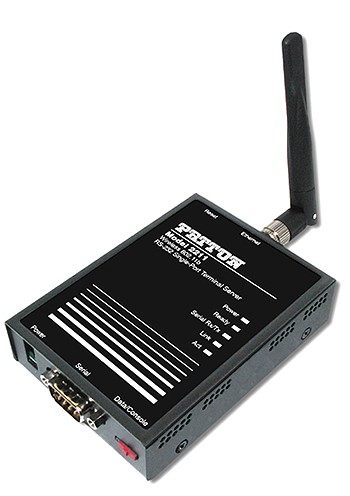
Patton 2211
EtherBITS™ Wireless
Single-Port Device Server
Best, most
cost-effective method to control, monitor, and collect data from your RS-232
serial devices over a wireless local area network.

The Patton 2211 Single-Port Device Server
is used to connect various RS-232 serial devices to the Local Area Network through their serial control ports. The 2211 enables monitoring, control, and data collection from this equipment by remote computers located anywhere on the local or wide area network. Both Ad hoc and Infrastructure mode is supported on the 2211.
Call
301-924-7400 ext. 17 for Information and Pricing
Get-A-Quote
COM Port redirector is provided for users who choose to use their existing serial communication application programs. Utilizing the COM Port redirector software provided on the Patton Model 2211 allows existing COM/TTY-based software to be preserved, thus no additional investment is required on additional software.
Ethernet continues to be the
predominant office networking infrastructure. Now, Ethernet has made its way
from the office to the shop floor. Traditional serial environments require the
use of multi-port serial cards, expensive cables, and the personnel to manage
multiple systems. Patton’s Model 2211 Single-Port Device Server provides a
quick, inexpensive, and hassle-free solution for connecting legacy serial
terminals and devices to a local area network (LAN).
The Patton 2211 links legacy serial RS-232 devices to the network by
encapsulating serial data into IP packets for transport over the wireless LAN.
Using TCP or TELNET, the Patton 2211 can connect to any user-defined IP address
and port. Once connected to the remote host, data is passed transparently
end-to-end. The built-in DHCP Client allows the Patton 2211 to dynamically
obtain an IP address and a subnet mask from a master server. COM Port Redirector
is included with Patton’s 2211 enabling companies to use their existing
COM/TTY-based software, preventing the hassle and expense of investing in
additional software.
Physical layer-connectivity is provided via an RS-232 serial port and a 10BaseT
Ethernet port. Configure the serial port’s data rate, ranging from 1200bps to
115.2 kbps, and choose from a variety of connector types including DB9 or DB25
male or female.
Patton’s Model 2211 offers the lowest transition cost in turning your serial
infrastructure to IP.
2211-25F/E EtherBITS Wireless RS-232 Serial Device Server;
10BaseT/802.11b; RS-232/DB25F
2211-25M/E EtherBITS Wireless RS-232 Serial Device Server; 10BaseT/802.11b;
RS-232/DB25M
2211-9F/E EtherBITS Wireless RS-232 Serial Device Server; 10BaseT/802.11b;
RS-232/DB9F
2211-9M/E EtherBITS Wireless RS-232 Serial Device Server; 10BaseT/802.11b;
RS-232/DB9M
Mechanical Interface:
Serial: DB-9M/F; DB-25M/F; Ethernet: WiFi 802.11b
Serial Transmission: RS-232 Rates from 1200 bps to 115 kbps
Ethernet Transmission: 802.11b Wireless Ad Hoc/Infrastructure Modes;
10Base-T Ethernet
Management: Monitoring, control, and diagnostics via serial port or
TELNET session
LED Indicators: Power, Ethernet Link and Activity
Power: External AC: 9–30 VDC, 300mA at 9 VDC
Compliance: EMC Directive 89/336/EEC, Low Voltage Directive 73/23/EEC; CE
Mark
Environment: Temperature: 40–122°F (5–50°C); Humidity: Up to 90%
non-condensing
Dimensions: 4.5L x 3.2W x 1.0H in. (9.0L x 5.3W x 1.9H cm)
Weight: Packaged: 0.66 lbs (300 g) Unit Only: 0.55 lbs (250 g